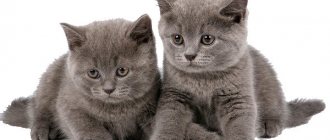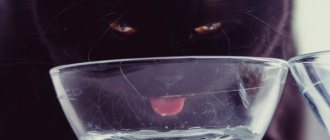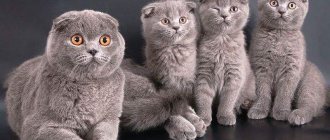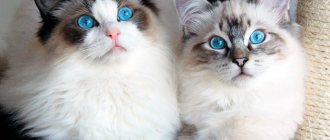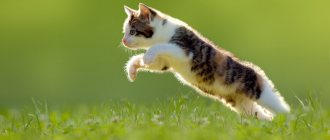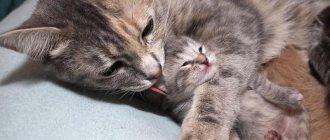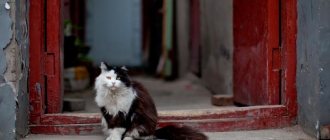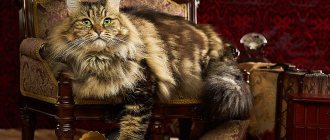Where is the best place to get a kitten?
It is better to purchase a British kitten from nurseries; it is advisable to find reviews (they must be positive about this breeder).
When the kitten turns 3 months old in the nursery, it will be ready to move to a new family, and the breeder will be able to prepare the necessary documents and give the baby vaccinations. This age is also favorable for the baby himself; his immunity will be more or less formed, which means the kitten will get sick less. Before taking the baby to a new home, you need to examine him so that there is nothing suspicious in appearance and the kitten looks healthy and active. Ask the breeder about the maintenance of the kitten, its nutrition, and read the pedigree of the parents.
Before purchasing a kitten, it is important to study its pedigree and talk to the breeder.
British kittens are distinguished from others by their plush dense coat, round eyes, compact, muscular body with a wide chest. These kittens also have a thick tail and full, short legs. The head should be round, with a wide muzzle, dense nose pads and cheeks.
When purchasing a kitten from a specialized nursery, you can be sure that:
- kitten from purebred parents;
- the veterinary passport reflects all vaccinations performed, including treatment against helminths;
- the kitten will have the metric to participate in exhibition events.
Characteristics of the British cat
What kind of eyes do the British have?
Against the backdrop of the expressive face of the British cat, the large and round eyes really stand out. They are always set wide apart and have a clean, bright look.
At 4 months, Britons' eye color usually begins to change depending on their coat color. Only an experienced specialist can tell you the final color result at this age. For example, a cat can become blue-eyed only if its coat is white.
Another feature of snow-white cats is the ability to have eyes of two colors: blue and yellow, gold and copper, blue and copper. Cats with silver colors and tabby patterns usually have green eyes. All other color variations of coat colors have mostly swamp eyes in childhood, gradually acquiring an amber, copper tint.
Note! The outline of the iris of the eyes of British cats should correspond to the general tone. A darker outline is considered a defect.
Why is it important to control your pet's weight?
If the weight of a British cat lags behind the standard indicators, it is necessary to find out and eliminate the cause of the deviations:
- Exhaustion of a nursing cat - kittens do not have enough milk. The mother's diet should be increased and qualitatively improved. Add fats and carbohydrates to the food. The veterinarian will recommend a complex of vitamins.
- Too many offspring. Perhaps stronger brothers do not give the kitten the opportunity to eat their fill and push them away from the mother's nipple. Providing artificial complementary feeding is a good solution to the problem.
If there are no visible reasons for weight loss, you should immediately consult a veterinarian.
Getting used to a new place and training to a tray
At first, the kitten will miss its previous home, meows at night, pick it up and stroke it, talk to it. Caring for British kittens at 2 months is exactly like this. At night, you can put him on a warm heating pad, wrapping it in a towel (this will remind him of his mother or the presence of other kittens nearby). Take your time, let the Brit get comfortable.
shutterstock
If the animal was purchased from a nursery, they are often already litter box trained. If not, then it won't be difficult. After feeding, take your Brit to the toilet. It is better to fill the tray with wood filler. He will like it there and will quickly remember where to go. The tray should always be clean, this is the key to avoiding embarrassment. If there is an embarrassment, then it is worth punishing the kitten.
This will develop a conditioned reflex and after the third time the kitten will understand that this is not worth doing. Never allow a cat's unacceptable behavior to go unpunished.
What kind of hair do British cats have?
Special attention should be paid to British wool. Thanks to the harsh living conditions in the past, these animals have acquired an excellent coat with a very dense and thick undercoat. Despite the fact that the structure of the wool itself is thin, it feels quite elastic and soft to the touch. Therefore, representatives of this breed are often called plush. In addition, the coat of British cats is distinguished by beautiful, shiny colors. British cat care and maintenance >>
At the moment, there are about 60 colors that the British have. It can be any solid color, smoky, tortoiseshell, tabby, chinchilla, bicolor or colorpoint. The most common among them are solid blue, as well as two-color tabby and chinchilla.
Important! The British Shorthair's coat should be the same length all over the body. As a rule, it does not exceed 2.4 cm.
A healthy British cat never develops tufts of fur, so he can easily take care of his coat on his own.
Safety first
Take care of the safety of the chosen toy for your kitten, because they are like children. There should be no parts that a Briton can swallow: excess fluff, elastic, shiny, small beads. Toys should be soft and made of good fabric. Avoid purchasing hard or sharp toys.
Make sure everything in the house is safe for the kitten:
- Close access to all the cracks where a Briton can climb in and not get out until he grows up;
- Keep the bags out of the reach of kittens, because they are such little naughty creatures, while playing, they can get stuck there and suffocate;
- Cover your trash at night. A British person will not be tempted to find and eat a sausage roll;
- Place nets on the windows so that the Briton does not stare at the bird and fly away with it;
- Don’t leave threads, raindrops, or balls in a place accessible to a Briton; he can easily eat it all;
- While the Briton is very small, be careful. He remembers that you may not notice him, step on him, sit down, lie down;
- Before the first vaccination, try to limit your pet’s contact with other animals and various objects from the street;
- Do not leave chemicals or detergents open or unattended;
- It is better to keep dry food in the pantry away from the cat.
What are the norms for weight gain for kittens?
The first six months of a kitten's life are the most active in terms of growth. Accordingly, if the baby is healthy and develops normally, he will regularly gain weight:
Before the baby turns 1 month old, he rapidly gains weight - about 15 g per day. At the same time, by the end of the 1st week, the kitten should double its birth weight. Weigh him daily during this period. From 1 to 2 months, weight gain occurs systematically, on average 100–150 g per week. Weigh the baby once every 3 days. After 2 months, weight gain varies from person to person. It depends on the breed and nutrition of the animal. He is weighed weekly for up to 6 months, then once a month for up to a year.
It is important that there is weight gain. If it is absent, you should contact your veterinarian to find out the reasons.
Since there are no exact indicators of body weight gain (much depends on the individual characteristics of the animal, its living conditions and diet), the owner should focus on the average weight standards for kittens.
Table: average body weight of kittens in the first 6 months of life
| Age | Weight |
| 1–6 days | 70–130 g |
| 7 days | 85–200 g |
| 7–14 days | 225–400 g |
| 14–21 days | 285–500 g |
| 1 month | 500–750 g |
| 2 months | 1000–1500 g |
| 3 months | 1700–2300 g |
| 4 months | 2500–3600 g |
| 5 months | 3100–4200 g |
| 6 months | 3500–4800 g |
Short-term stabilization of weight in a kitten
The phenomenon of short-term weight stabilization often occurs. There is no need to panic if the kitten’s weight gain “frozen” for several days, and then continues in the same progression.
Such an anomaly can manifest itself at any time stage of the baby’s life. It often occurs when there is a transition from breastfeeding to regular food (dry food or natural food). This is due to the fact that the baby’s body goes through a period of adaptation to receiving new nutrients.
However, you should worry if there are no changes for more than a few days (for example, a week). This may mean that the kitten is malnourished or sick or infected with parasites. You should visit a veterinarian as soon as possible if, after weight stagnation, body weight begins to decrease rather than increase.
Table: kitten weights by month (values for popular breeds)
| Kitten age | Maine Coon cat weight (g) | Catamein Coon weight (g) | British cat weight (g) | British cat weight (g) | Scottish cat weight (g) | Scottish cat weight (g) |
| Newborn kitten | 120–140 | 120–160 | 60–140 | 70–140 | 60–140 | 70–140 |
| 1 Week | 180–230 | 200–260 | 110–250 | 240–260 | 110–250 | 240–280 |
| 2 week | 280–340 | 400–360 | 150–360 | 340–400 | 140–360 | 340–400 |
| 3 week | 420–550 | 440–600 | 210–420 | 400–630 | 200–420 | 390–630 |
| 4 week | 560–680 | 630–750 | 250–600 | 550–740 | 240–600 | 540–740 |
| 2 months | 1100–1400 | 1200–1500 | 450–900 | 1000–1700 | 400–900 | 1000–1700 |
| 3 months | 1700–2300 | 1800–2300 | 1000–1500 | 1500–2500 | 1000–1500 | 1500–2500 |
| 4 months | 2700–3600 | 3000–3800 | 1700–2400 | 2100–3900 | 1700–2400 | 2100–3900 |
| 5 months | 2900–3900 | 3000–5500 | 2200–2900 | 2600–4300 | 2200–2900 | 2600–4300 |
| 6 months | 3200–4000 | 3900–6000 | 2300–3600 | 3000–5400 | 2300–3600 | 3000–5400 |
| 7 months | 3500–4100 | 4200–6500 | 2400–3900 | 3300–5600 | 2400–3900 | 3300–5600 |
| 8 months | 3800–4300 | 4500–6900 | 2500–4100 | 3500–6000 | 2500–4100 | 3500–6000 |
| 9 months | 4100–5000 | 5000–7000 | 2500–4300 | 3800–6400 | 2500–4300 | 3800–6400 |
| 10 months | 4200–5500 | 5200–7700 | 2500–4400 | 4100–6700 | 2500–4400 | 4100–6700 |
| 11 months | 4300–6000 | 5700–8000 | 2500–4500 | 4300–6800 | 2500–4500 | 4300–6800 |
| 12 months | 4500–6300 | 5700–9000 | 2500–4600 | 4500–7000 | 3500–4600 | 4500–7000 |
How to determine weight standards for a mongrel kitten
When it is not possible to determine what breed a kitten is, it is necessary to use average indicators. The size of the baby will change in accordance with its development. There are a number of factors that allow you to predict a kitten’s weight gain. For example, when he switches from breast milk to a normal diet, the weight may decrease slightly.
After the 6th month of life, weight gain is not of decisive importance. If the cat is active, eats well, and has no problems visiting the litter box, then there is no need to worry too much. The veterinarian should be observed on a schedule determined by the doctor (basically it coincides with the vaccination schedule).
Having mongrel cats and a dog adopted from the street, I regularly visit the veterinarian. All my animals have veterinary passports, are vaccinated and sterilized. This way I protect not only them, but also my family. After all, some diseases (and at least the same worms) can be transmitted to humans. Since my children play with animals, I have a strict order in this matter.
Normal weight of kittens
Immediately after birth, based on the kitten’s build, you can understand what build it will be in the future and what size it will reach when it grows up.
Good care and good nutrition will have a great impact on the baby's development. But to find deviations in weight, you need to know the norms and regularly monitor them.
- Weight in the first days after birth. Newborns can weigh 70-130 g. By the second week, kittens gain 110-150 g. If the kitten weighs less, this may indicate that the nursing cat is not receiving the required amount of vitamins from food.
- Weight in the second week after birth. At this time, the weight can gain another 210 g on average. Activity appears, eyes may begin to open. According to the breed standard, a kitten in this period should weigh 420 g.
- Weight until the end of the first month after birth. At this time, the owner can begin to introduce complementary foods (boiled chopped chicken, beef, canned cat food, cottage cheese, boiled yolk), especially for babies with a large number of kittens in the litter. During this time, the “fluffy” should gain another 250 g. Under good conditions, its weight during this period can reach 500 g, at the beginning of the fifth week - 600 g, in two months - 700-1500 g.
- Weight until the end of the third month after birth. With proper care and nutrition, a kitten can weigh more than 1 kg by three months. Every day he gains 100 g. According to the norm, during this period the weight of a kitten on average reaches 1.5-2 kg for a cat and 1-1.5 kg for a cat. If during this period the kitten still receives mother's milk, it is necessary to ensure the supply of vitamins and provide a variety of complementary foods. You should not give kittens at this age natural pork, smoked meats, fatty dairy products, chicken with bones and river fish.
- Weight until the end of the fourth month after birth. By standards, kittens at this age weigh 1.7-2.4 kg (females), and males 2.1-3.9 kg. Now the kitten looks more like an adult animal. Depending on diet and heredity, a kitten can gain 2 kg. You need to take a closer look at a kitten weighing more than 4 kg: perhaps the amount of food can be reduced.
- Weight until the end of the fifth month after birth. By the beginning of the fifth month, a cat can weigh 2.2-2.9 kg, and a female cat can weigh 2.6-4.5 kg. Now the period of growing up begins, and by the time the kitten finally becomes an adult, the kitten will double its weight.
The pet is three months old
Watching how a Briton grows and develops is very interesting. But this is also useful, because sometimes it allows us to identify pathologies at an early stage of development. And for breeders, this is also a way to track the purity of the genetic line and keep their pet at an ideal weight for exhibitions and competitions.
The kittens are already quite large, and every day they can gain 100 grams, thus becoming even more massive. This is good for the development and normal weight of the British dog, because adult animals can reach 8 kg in weight.
British kittens aged 3 months shutterstock
It is important that at this age your pet eats a balanced diet. If he has not yet been weaned off his mother’s milk, the amount of vitamins in his mother’s food needs to be increased, and feeding should become more varied.
Which food to choose
At this age, owners must decide what they will continue to feed their pet. Watch what a British person eats with great pleasure. If you choose store-bought food, give preference to good food, which can cost a lot. An excellent option is the products of the American company Hills. Also high-quality food from such manufacturers as Innova EVO and Orijen.
If you decide to stick to natural food, it’s worth remembering the foods that you should never give to a British breed pet:
- all types of river fish;
- pork meat;
- smoked sausages and other “human” food;
- fermented milk products with a high fat content (sour cream, cream, etc.);
- chicken meat with bones.
Combined meals are not a good idea. It will be better for the baby if you stop at one thing. If you choose natural food, you should have enough time to prepare it. It is not advisable to feed your baby the same thing that you eat yourself, since a cat’s digestive system is very different from a human’s.
Weight of a kitten from birth to one year by month. All breeds
The weight of a cat depends primarily on the breed, lifestyle and nutrition. For example, the large Maine Coon breed: the weight of a kitten at birth is already greater than the average weight of a cat and is about 130-150g; for comparison, the weight of a Scottish kitten is 80-120g. In the Scottish breed, the weight of fold-eared cats and straight-eared cats does not differ. British kittens also weigh approximately 80-130 grams at birth.
The weight also differs by gender, for example, the weight of a British cat is 5-7 kg, and the weight of a British cat is 3-5 kg (weight of British cats by month). Read all about the British breed here. The table shows the dynamics of the cat's weight by month: the weight of a Maine Coon kitten, the weight of a British kitten by month, the weight of a Scottish kitten by month.
The cat's weight by month shows a general trend of intensive growth in the first month, then the weight is gained a little more slowly, the cat's weight per year practically reaches its maximum, a stable normal weight of the cat is achieved at about 2.5 years. The cat's weight is shown in the table, first by week, then by month.
KITTEN IS NOT GAINING WEIGHT. WHAT TO DO?
Compare the weight and age of the kitten using the table. With proper care of the kitten, weight indicators should be normal. Although the development of kittens of each breed, and each animal can be individual.
If your kitten is not gaining weight, there may be several reasons. Firstly, there are many kittens in a litter, for example 5-6 or more, and then, perhaps, the baby simply does not have enough milk or a free nipple. Make sure he eats, put him close to his mother cat more often.
If there are really a lot of kittens, it is necessary to feed the kittens with special milk for kittens (can be bought at a pet store) from a pipette or pacifier.
If even after this the kitten does not gain weight, it is most likely sick and you should urgently contact a veterinarian.
After switching to dry food, kittens from a large litter most often reach average weight.
ADULT ANIMALS. HOW TO GAIN WEIGHT FOR A CAT?
It happens that kittens at 7-9 months stop gaining weight or even lose it altogether. This is most likely due to the fact that at this time they go through puberty and hormonal changes.
An adult cat does not gain weight for the same reason. If your cat's estrus is long and frequent, be sure to give sedatives, but do not breed animals before a year (only on the recommendation of a veterinarian). Early matings have serious consequences. See the table for the normal weight of a cat. With proper care and maintenance, the weight should correspond to age and breed.
Kitten weight table by month
The weight of the kitten by month is indicated separately for the cat and for the cat.
- weight and age of the kitten by month
- maine coon cat weight
- maine coon cat weight
- british cat weight
- british cat weight
- Scottish cat weight
- Scottish cat weight
| 1 | 2 | 3 | 4 | 5 | 6 | 7 |
| Newborn kitten weight | 120-140 | 120-160 | 60-140 | 70-140 | 60-140 | 70-140 |
| Kitten weight 1 week | 180-230 | 200-260 | 110-250 | 240-260 | 110-250 | 240-260 |
| Kitten weight 2 weeks | 280-340 | 300-360 | 150-360 | 340-400 | 140-360 | 340-400 |
| Kitten weight 3 weeks | 420-550 | 440-600 | 210-420 | 400-630 | 200-420 | 390-630 |
| Kitten weight 4 weeks/1 month | 560-680 | 630-750 | 250-600 | 550-740 | 240-600 | 540-740 |
| Kitten weight at 2 months | 1,1-1,4 | 1,2-1,5 | 450-900 | 1,0-1,7 | 400-900 | 1,0-1,7 |
| Kitten weight at 3 months | 1,7-2,3 | 1,8-2,3 | 1,0-1,5 | 1,5-2,5 | 1,0-1,5 | 1,5-2,5 |
| Kitten weight at 4 months | 2,7-3,6 | 3,0-3,8 | 1,7-2,4 | 2,1-3,9 | 1,7-2,4 | 2,1-3,9 |
| Kitten weight at 5 months | 2,9-3,9 | 3,2-5,5 | 2,2-2,9 | 2,6-4,3 | 2,2-2,9 | 2,6-4,3 |
| Kitten weight at 6 months | 3,2-4,0 | 3,9-6,0 | 2,3-3,6 | 3,0-5,4 | 2,3-3,6 | 3,0-5,4 |
| Kitten weight at 7 months | 3,5-4,1 | 4,2-6,5 | 2,4-3,9 | 3,3-5,6 | 2,4-3,9 | 3,3-5,6 |
| Kitten weight at 8 months | 3,8-4,3 | 4,5-6,9 | 2,5-4,1 | 3,5-6,0 | 2,5-4,1 | 3,5-6,0 |
| Kitten weight at 9 months | 4,1-5,0 | 5,0-7,0 | 2,5-4,3 | 3,8-6,4 | 2,5-4,3 | 3,8-6,4 |
| Kitten weight at 10 months | 4,2-5,5 | 5,2-7,7 | 2,5-4,4 | 4,1-6,7 | 2,5-4,4 | 4,1-6,7 |
| Kitten weight at 11 months | 4,3-6,0 | 5,7-8,0 | 2,5-4,5 | 4,3-6,8 | 2,5-4,5 | 4,3-6,8 |
| Kitten weight at 12 months/1 year | 4,5-6,3 | 5,7-9,0 | 2,5-4,6 | 4,5-7,0 | 2,5-4,6 | 4,5-7,0 |
| Adult cat weight and adult cat weight | 4,5-7,5 | 5,7-10,0 | 2,5-5,5 | 4,5-8,0 | 2,5-5,5 | 4,5-8,0 |
| Weight of castrated/sterilized cats and female cats | 4,5-10 | 5,7-12,0 | 2,5-6,0 | 4,5-9,5 | 2,5-5,8 | 4,5-9,0 |
We will also consider and compare the weight of cats of different popular breeds: Bengal cat, Siberian cat, Abyssinian cat, Russian Blue cat, Bobtail, Norwegian forest cat, Siamese cat and many others.
| 3.4-6.1 |
| 4.0-7.2 |
| 3.1-5.5 |
| 3.8-6.9 |
| 3.6-6.5 |
| 3.2-5.8 |
| 3.1-5.5 |
| 4.0-7.2 |
| 3.6-6.5 |
| 3.6-6.5 |
| 3.0-6.8 |
| 3.1-5.5 |
| 3.4-6.1 |
| 3.2-5.8 |
| 3.8-6.8 |
| 2.8-5.1 |
| 3.0-5.4 |
| 3.5-6.3 |
| 2.7-4.8 |
| 3.2-5.8 |
| 3.5-6.3 |
| 3.2-5.8 |
| 5.8-10.5 |
| 2.5-4.5 |
| 3.2-5.8 |
| 3.0-5.3 |
| 4.4-7.9 |
| 3.8-6.8 |
| 2.5-4.5 |
| 5.0-9.0 |
| 3.6-6.6 |
| 3.1-5.5 |
| 4.0-7.2 |
| 2.5-4.5 |
| 3.4-6.1 |
| 3.25.8 |
| 3.4-6.1 |
| 4.0-7.2 |
| 3.5-6.3 |
| 3.3-5.9 |
| 4.0-7.2 |
| 3.8-6.9 |
| 3.0-7.2 |
| 3.8-6.8 |
| 2.8-5.1 |
| 2.8-5.1 |
Track your pet's weight and make sure he grows up healthy!
Basic information, features, facts
Advantages of the breed:
- They are calm about the absence of the owner;
- Long life expectancy at home;
- Balanced;
- Smart;
- Good patience;
- Good health;
- They don't bite, they're not angry. The Angry Brit is a rarity;
- Easy care;
- Plush antidepressant.
Disadvantages of the breed:
- Chooses one owner-friend;
- Allows herself to be stroked when she wants it;
- British fur coats can cause allergies;
- Afraid of colds.
Weight of a British cat, to what age do they grow, life expectancy?
How old do they grow? Shorthairs are slow to mature, being fully formed by about 3 years of age, some do not reach maturity until 5 years of age.
An adult Briton weighs from 5 kg – 9 kg. Girls are smaller and weigh from 3.5 kg to 7 kg. Spayed and neutered animals gain slightly more weight. It all depends on proper nutrition.
Table - weight (g) of a British kitten by month
| Age | Boys | Girls |
| Newborn kitten weight | 65 — 140 | 60 — 130 |
| 1 Week | 230 — 270 | 120 — 240 |
| 2 weeks | 330 — 410 | 145 — 350 |
| 3 weeks | 390 — 620 | 200 — 410 |
| 4 weeks | 1 month | 545 — 740 | 245 — 550 |
| 2 months | 990 — 1650 | 440 — 900 |
| 3 months | 1450 — 2600 | 1000 — 1450 |
| 4 months | 2000 — 3800 | 1600 — 2300 |
| 5 months | 2500 — 4200 | 2100 — 2800 |
| 6 months | 2200 — 3500 | 2900 — 5300 |
| 7 months | 3200 — 5500 | 2300 — 3800 |
| 8 months | 3450 — 5900 | 2450 — 4000 |
| 9 months | 3700 — 6300 | 2400 — 4200 |
| 10 months | 4000 — 6600 | 2400 — 4300 |
| 11 months | 4200 — 6700 | 2400 — 4400 |
| 12 months | 1 year | 4400 — 6900 | 3000 — 4500 |
| Adult | 4500 — 8000 | 3500 — 5400 |
| Castrated | sterilized | 4500 — 9000 | 3500 — 6000 |
How many years do they live? The life expectancy of a British cat is influenced by certain factors: the presence of genetic diseases, proper feeding and care, vaccination, veterinary examinations, indoor or outdoor keeping, castration | sterilization.
Lifespan 12 – 16 years.
Basic physiological data of healthy cats, briefly
Body temperature (rectal): 38 – 38.5 ⁰C.
Pulse:
- Kittens: 180 – 200 beats. /min;
- Adult cats: 110 – 140 beats. /min.
Breathing rate: 10 – 20 / min.
Sexual maturity:
- Cat: 6 – 12 months;
- Cat: 6 – 15 months.
Estrus: 2 – 4 times/year.
Duration of estrus: 10 – 12 days.
Favorable period for mating: during estrus.
Duration of pregnancy: 55 – 65 days, depending on the breed.
Age of a cat by human standards
| 18 months - 20 years | 9 years – 52 |
| 20 months – 21 years old | 10 years – 56 years |
| 22 months – 22 years | 11 years – 60 years |
| 2 years – 24 years | 12 years – 64 |
| 3 years – 28 years | 13 years – 68 years |
| 4 years – 32 years | 14 years - 72 |
| 5 years – 36 years | 15 years – 76 years |
| 6 years – 40 years | 17 years - 84 |
| 7 years – 44 g. | 19 years - 92 |
| 8 years – 48 years | 20 years – 100 years |
Behavior, character, habits
The British Shorthair is soft and calm, an excellent family companion. Loves affection, but is not the “me, me, me” type of cat. Will follow you around the house throughout the day, settling nearby wherever you go. These cats are unlikely to lie on your lap and do not like to be carried or held. Will enjoy the company of their human family members, spending time playing or sleeping in the same room. They are felines with a moderate level of activity. Energetic as a kitten, but begins to calm down when he is one year old. More mature British Shorthairs are usually “coolies”, but older males sometimes act like goofballs. When running around the house, they can sound like a herd of elephants.
Behavior in public places, instincts.
Each kitten has its own character and habits. British cats are calm towards strangers. One will make contact immediately, the other will observe from the side. If a cat rarely goes to public places or transport, he will be wary and hide - this is a normal reaction to an unfamiliar environment.
The British are an artificially bred breed, but the instincts have not gone away. British cats are excellent hunters, tested at the dacha and based on reviews from owners; Often cats need help during childbirth.
Attitude to extraneous sounds.
Extraneous sounds, rustles, objects arouse interest, and as a result the cat goes to investigate. At such moments, you need to come up and support, stroke and calm her, and explain. When the vacuum cleaner is running, they go into another room, there are cats from our litters who are absolutely calm about the vacuum cleaner, the new parents of the kittens said.
Behavior in the house, how to properly organize space.
The British love to play, the most active age is up to 4 months, they remain playful for up to a year, after which they become adults, important, calm, sleep and watch more. Based on observations of our pets, I can say that they love high play structures and sleep in houses only when it’s cold. Britons are large and weighty, so the complex with the scratching post must match. Among the toys they like are “flyers” with feathers or leather ropes, bouncy balls, and mice; mazes, boxes, etc. The main thing to remember is that the toy must be safe. British adults love to spend time with their owners at the computer and TV.
Toys, treats, suitable types of entertainment, is training possible?
Kittens love toys, especially new ones; if there is no new one, they can invent a toy for themselves: they will steal a hair tie (very dangerous because they can eat it), a candy wrapper, a piece of paper, or a cap from a plastic bottle. One of our graduates in her new house got used to removing a corner from the baseboards and moving it around the house.
They won’t refuse “sweets”; our pets have treats: vitamins, wet food and canned food.
Training is possible; in our nursery, from childhood, we teach him a scratching post, a name, a tray, and the word “no.”
Solitary behavior, sabotage, useful activities.
The British tolerate loneliness calmly, of course we are talking about the time when the owners are at work, mostly cats eat and sleep at this time, waiting for the evening.
If a Briton is offended, he will definitely show his dissatisfaction, he may be harmful, this will happen right away, he will not accumulate resentment.
British cats are for any movement in the house, for any repairs, they love to take part in it.
Communication with other animals, children, owner. Aggressiveness.
If a British cat is pedigree, she has pedigree titled parents, then 99%, she will be balanced, because... unbalanced ones are disqualified from examination and should not go into breeding, so it is important when buying a kitten to contact official nurseries.
Our beauty came to us before the birth of the child, but she accepted her daughter calmly, even slept with her in the crib. The kittens already appeared with the child, grew up, played together.
If the cat is “loner”, it will react aggressively to any strange animal.
Emotionality.
It all depends on the character, one is more emotional and loves to talk, the other is calm.
If a British cat is not bothered by anything, it will behave calmly; if the cat has problems, it will definitely show it.
Several pets in the house, intersexual relations, attitude towards other pets.
While the mother is feeding, she treats the kittens normally, when the kittens grow up, she begins to be loyal to someone, while others can be annoying. Cats do not have the concept of mother-son; a cat-son can breed a cat-mother. Cats and cats can live together if they psychologically tolerate this living well. They are separated during estrus.
They bought kittens from us for a house where dogs lived, they all adapted and got along fine.
Attitude to heat and cold.
The British don't like hot beds. In summer, they often look for cool places (floors, tiles); in autumn and spring, before heating, vice versa. They sleep where they want and how they want, there is no one favorite place.
In what situations do they vote? How clean?
Depends on the character. The cat wants to talk - talk to him.
The British are very clean, they demand clean bowls and fresh water - this is right. They don't like to swim, but they tolerate it steadfastly.
Health, care
The British breed is healthy and does not suffer from many genetic problems. May have diseases: hemophilia B, hypertrophic cardiomyopathy, polycystic kidney disease, gingivitis.
Brush your teeth to prevent periodontal disease. Daily oral hygiene is best, but weekly brushing is better than nothing. Trim nails weekly. Wipe the corners of your eyes with a cotton pad containing a special solution to remove any discharge. Use a separate cotton pad for each eye to prevent infection from spreading.
Check your ears weekly. If they look dirty, dry them with a cotton pad and ear spray.
Correct British wool is similar to a mouton (plush), short, elastic, with a good undercoat. With a properly balanced diet, maintenance is minimal. We bathe cats once a year, brush them a couple of times a week with special combs or a rubber comb. During the molting period, you have to brush more often. The main thing is to choose the right care products and balance your diet. You cannot use slicker brushes with fine teeth without protected ends, you cannot wash them frequently, it is better to use special napkins for wool.
Omnivorous, prone to obesity.
The British are not very active; they prefer to lie down. The tendency towards inactivity means that you need to play with your cat regularly for its health and mental stimulation.
The British are picky eaters; if you find good food, the problem will go away. Neutered or sterilized cats are prone to overeating and obesity. We are responsible for those we have tamed and must monitor what we feed and in what quantity. It is better to use special feed, following the norm depending on the weight of the animal.
Read more about feeding here.
What to do if your Bengal begins to gain weight poorly
Having noticed deviations in weight gain, you should determine the reasons for this.
Bengals are one of the cat breeds that lead an active lifestyle.
A few common reasons:
- Poor nutrition. Underweight occurs if the kitten is malnourished or does not receive enough nutritional components. Make sure that the kitten eats 6 times a day and has constant access to clean drinking water.
- Refusal to eat. This problem especially often occurs among owners who purchased a kitten from a breeder. The pet may already be accustomed to a certain food and refuse to eat a new one. In this case, you should transfer the kitten to a new food gradually.
- Stress. Sudden changes in environment and other factors can provoke stress. When stressed, kittens may refuse to eat. As a rule, adaptation takes from a couple of days to a week, after which the pet begins to eat normally and gain weight again.
- Diseases. If a Bengal eats properly, but still does not gain weight well, this may indicate diseases of the digestive system. In this case, you should definitely show your pet to a veterinarian.
- Parasites. Weight loss may indicate the presence of worms. Prevention against parasites should be carried out every six months starting from three weeks of age. For kittens, a suspension is used: it is easier to administer into the body.
Be sure to read:
All 6 Cat Breeds with Short Legs: Bambino, Munchkin, Napoleon, Lamkin, Kinkaloo and Skookum
Bengal cat: breed description, size and weight
Wild leopard cats combine the predatory grace and gentle nature of an ordinary pet. The work of breeders makes it possible to keep the animal at home, without suffering either the animal or the owner. Bengals are notable for their loyal nature and love of play.
They are suitable for a large family, where they can receive special attention. This breed is endowed with a strong, large body and sinewy paws.
Therefore, the standard sizes and weight of a Bengal cat differ in many ways from other breeds.
Small domestic leopards can be recognized by the following standards:
- neat wedge-shaped head;
- eyes are set wide apart and can be of any shade (blue only with white color);
- small, rounded ears;
- powerful, short neck of equal width with transition zones;
- large bones and elongated hind legs;
- the front paws are particularly dexterous (can carry objects);
- a dense tail of medium length, tapering at a black tip.
The main feature of Bengals is their color and coat structure. Short but dense shiny hairs give the coat a rich look and make it pleasant to the touch. Long hair in this breed is rejected.
Exotic spots on the body indicate wild genes. Bengal cat kittens may lose them for a while as they grow up (up to a year). This phenomenon is absolutely normal and is not a defect.
The main colors include:
- spotted, characterized by small spots randomly scattered throughout the body;
- rosette, combining spots of various sizes and stripes extending from them;
- marbled, practically or completely eliminating spotting.
There is a silver snow bengal that can have any of the above colors.
Domestic Bengals have impressive sizes: males can reach 8 kg, females - 5-6 kg. The total length of the body is approximately 90 cm, and the height at the withers is 41 cm.
Bengal kittens grow quickly. By the end of the first week, they become 2 times larger than the parameters obtained at birth.
The size and weight of a Bengal cat depend on the parents involved in creating the offspring. Approximate indicators of kitten development by month can be found in the table:
Age (month)
Weight, kg)
The following points are worth remembering:
- initial weight changes over the course of a week;
- a one-month-old kitten should weigh about half a kilo;
- after 1 month of life and up to 3 months, growth is slow;
- when you step over 1 kilogram, growth will accelerate;
- a new slowdown will occur in the 7th - 9th month and will finally stop in females;
- males continue to increase their parameters up to 2 years.
If deviations from the norm are observed, it is worth consulting with a specialist and analyzing the animal’s nutrition.
The large weight and height of Bengal cats is already inherent in nature itself. In order for it to meet the standards throughout life, you need to follow some rules.
Proper care of Bengal kittens:
The kitten's weight must be recorded every day. This will help track how many grams he has gained
Fourteen days after birth, you can no longer monitor your weight so often; once every 3 days is enough. If kittens that have not been weaned from the cat slowly gain weight, you should pay attention to the mother’s diet. It must be of high quality and balanced
For normal weight gain in kittens, it is necessary to add more protein and vitamins to the cat’s menu. If this measure does not produce results, the kitten should be shown to a specialist to rule out the presence of diseases. If the baby loses weight, you can feed it with industrially produced compounds specially designed for kittens of this breed.
Causes of weight loss in adulthood:
- Changing your diet. A Bengal may not like new food. It is recommended to choose food of the same brand. If the cat is on a natural diet, each new product should be introduced gradually, in small quantities.
- Parasites can cause your cat to lose weight. It is imperative to prevent infection with worms and fleas.
- Weight loss can be a consequence of any disease. If changing the menu and treating for worms does not help, you need to consult a veterinarian.
Height and weight of British cats
Representatives of the British breed have a rather large build by nature and, accordingly, the British also weigh quite a bit. In addition, the weight of an adult cat depends on its lifestyle and diet.
The normal weight of a newborn British kitten, regardless of whether it is blue or chocolate, should be between 60 and 140 grams. Moreover, its size ranges from 9-14 cm. How to name a British kitten >> How to name a kitten based on the length of its fur >>
Considering that the British grow up to the age of 5, we suggest finding out in more detail what size the animal grows to each year.
The table shows the weight of British people depending on gender.
| British age | British cat weight | British cat weight |
| 1 year | 2-4 kg | 4-6 kg |
| 2 years | 2.5-4.5 kg | 4.5-6.8 kg |
| 3 years | 2.8-4.8 kg | 4.7-7 kg |
| 4 years | 3.8-5 kg | 4.9-7.5 kg |
| 5 years | 4-6 kg | 5-8 kg |
So, the average weight of a mature British adult can be from 4 to 8 kg. Today, the largest representative of the breed, named Chest, weighs 12 kg! Moreover, this is not the maximum weight of a pet. Since he is only 4 years old, the cat will probably grow up.
The largest British cat in the world >>
The British cat is truly a bright representative of the oldest purebred pets. Its extraordinary resemblance to a children's plush toy can inspire anyone to believe in the best and calm them down after hard everyday life.
More articles on this topic: All about the British breedTypes of British catsThe health of British cats History of the British breed
First month
This period of a pet’s life is the most difficult. In the first days of life, it becomes clear how strong the cat's physique will be when he grows up, what weight he can reach. Scientists have experimentally proven that nutrition and care in early childhood determine the health of an animal in the future. If the baby did not eat well in the first days of life, this will most likely affect his weight in the future.
First days of life
Kittens of the British and Scottish breeds weigh relatively a lot. Adult animals of these breeds are quite large, but even kittens are born real heavyweights.
Newborn kittens weigh from 70 to 130, but by the second week of life they become almost 1.5 times heavier (110-150 g). The babies are still blind, inactive, sleep a lot and eat a lot.
During this period of development, you need to make sure that the mother receives enough vitamins (more than she herself needs), because kittens need good breast milk with a balanced set of nutrients.
Second week
Over the next few days, the British kitten gains weight and by the end of the second week its body weight should already be 210 grams. Normally, it can reach even 420 grams. At the same time, babies become more active and mobile, some “early” babies even open their eyes by the end of the second week.
shutterstock
Up to a month
From the third or fourth week (depending on the rate of development of the British cat), you can start feeding. But not all foods can be eaten by him - we recommend that you first read what to feed your Briton.
If your Brit is active, eats a lot and has several siblings who also drink breast milk, it's time to start complementary feeding.
At the age of one month, kittens typically gain 250 grams of weight. Large, fast-growing babies can reach a maximum of half a kilogram, and this is quite normal.
Weight table by month
Start of complementary feeding
The first dishes that can be given to a British baby are:
- crushed canned cat food;
- chopped boiled beef or chicken;
- boiled sea fish;
- cottage cheese;
- boiled egg yolk.
From the first days of complementary feeding, carefully observe how your baby eats and how he reacts to food. If you prefer to feed your pets food, you should not skimp on it, because as a result, this can provoke the development of urolithiasis.
Tips for maintaining normal weight
To keep a British cat's weight within normal limits, owners need to maintain a balanced diet:
- add a small percentage of cereals and vegetables to dry and soft food;
- add boiled vegetables to the food (various varieties of cabbage, beets);
- meat and fish should only be lean, they should be included in the menu daily;
- Among the cereal products, it is best to give your cat oatmeal, millet, and rice;
- You need to cook porridge for your pet in water, without adding sugar and salt.
A kitten is taught to eat cereals and vegetables from an early age. The diet of an adult British cat should consist of 10–15% vegetables and cereals, 85–90% meat and fish.
Also, we must not forget about regular physical activity. To prevent a cat from developing obesity, the owner must engage it in active games every day.
High-quality and balanced nutrition, an abundance of vitamins and nutrients, an active lifestyle - these are the main factors for the full development of a British pet.
The owner should weigh the kitten at the same time every day in order to notice weight deviations in time. If the development of the “British” does not correspond to his age, then there is no need to hesitate in going to the veterinarian.
Cat breed British weight
It is quite easy to distinguish a British cat from an ordinary cat. It is always a “powerful”, squat and harmonious animal with rounded shapes. The chest of a large British cat looks wide, and the shoulders and back are massively dense, which is why the pet sometimes seems fat. The British cat has a smaller body shape, but with similar features.
Fold-eared Briton - reality or myth>>
Mating, pregnancy, birth of British breed cats >>
Representatives of the breed can also be identified by their relatively muscular and short legs, which have a slightly rounded shape. The tail of British cats resembles a conical shape with a rounded tip.
The most easily recognizable characteristics of the British are their expressive face and plush coat.
The face of a British cat always has well-developed cheeks, which are often called sideburns. The general description of the facial expression of British cats includes a benign, friendly look and a natural “smile” like the Cheshire Cat from “Alice in Wonderland.” The main advantage of these pets is their velvet-plush fur, in which your hands sink. Regardless of whether it is a shorthaired or longhaired Briton, its coat should have an elastic, fine texture and a fluffed undercoat. Types of Britons >>
In order to choose the right purebred, elite Briton, we recommend that you study in advance the distinctive features of the breed, its standard and seek help from a felinological organization that will provide you with the addresses of worthy nurseries.
Why does a British cat have a hanging belly?
Many owners of British breed cats often notice a saggy belly on their pet. And, naturally, they ask the question: “Isn’t this dangerous for health?” So, this is not a reason to panic at all. This is how British cat physiology works, and not only that! Even mongrel cats often have droopy bellies, just in a less pronounced form.
A fat tail is not a flaw in the exterior; experienced experts at exhibitions do not even pay attention to it. The only period when a British cat's belly disappears is during feeding, after which it appears again
Therefore, in no case should you cut down on the animal’s nutritional intake, since a thin British cat has a much larger fat fold. The British dog must look “appetizing” so that all its rounded shapes are clearly expressed, and then the pouch on the belly will only decorate the pet.
Characteristics of British cats
The British Shorthair cat is valued not only for its cuteness and intelligent, kind look. This “fur” miracle has a calm temperament and good health.
The British are great for business people who spend most of their lives at work.
Pets love to retire for long periods of time so that no one disturbs their sweet sleep. However, this characteristic of a cat being like a teddy bear does not mean that it can be treated like a toy. The Briton will never allow his dignity to be humiliated.
Character and habits of British cats >>
Many owners complain that cats of this breed are unsociable and rarely allow them to be cuddled. But this does not mean that they do not show their love and affection for their owner. It's just that British cats are more restrained in expressing their feelings and are quite self-sufficient, unlike other breeds.
But information about the aristocratic behavior of a Briton from an early age pleases any “cat person.” After all, these pets are very clean and will never allow themselves to relieve themselves in the wrong place. In addition, British cats love to take care of their appearance on their own - they can spend half of their active time on licking and washing themselves in order to always look respectable and radiate charm and charm!
